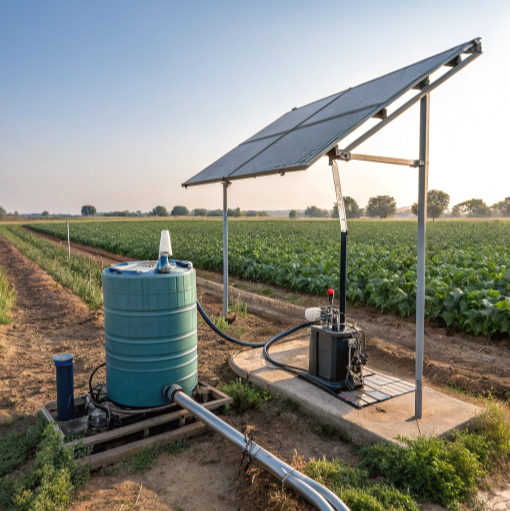How a Solar Water Pump Can Help African Farmers Irrigate During Dry Seasons?
by
How a Solar Water Pump Can Help African Farmers Irrigate During Dry Seasons?
Struggling to water crops during relentless dry spells? African farmers face devastating harvest losses yearly. Solar water pumps offer a revolutionary, sun-powered solution to secure irrigation and livelihoods.
Solar water pumps enable reliable irrigation in sun-rich regions by converting solar energy into hydraulic power, eliminating grid dependence and fuel costs while ensuring consistent water access during droughts.
Transitioning to solar-powered irrigation isn't just about technology—it's about transforming agricultural resilience. Let's explore why this innovation is becoming Africa's farming lifeline.
No Electricity? A Solar Water Pump Works Anywhere Under the Sun!
Frustrated by power outages ruining irrigation cycles? Solar pumps liberate farms from grid limitations, turning abundant sunlight into endless water access.
Solar water pumps operate independently of electrical grids using photovoltaic panels, providing uninterrupted irrigation in remote areas through direct DC power conversion or battery-free daytime operation.
The Off-Grid Advantage: Why Solar Triumphs Where Grids Fail
African farms frequently suffer from erratic grid power and costly infrastructure gaps. Solar pumps overcome this through:
Energy Independence Mechanism
- Direct DC Systems: PV panels power pumps immediately without batteries, slashing costs.
- Battery Backup Options: Store surplus energy for night/drizzle irrigation (e.g., 5kWh Li-ion units).
Installation Simplicity
Solar setups avoid complex trenching and transformers. A typical 3HP system requires only:
- Ground-mounted panels (6-8 units)
- Submersible pump
- Charge controller
| Feature | Diesel/Grid Pump | Solar Pump |
|---|---|---|
| Grid Required | Yes | No |
| Installation | 2-4 weeks | 3-5 days |
| Range | Grid-proximity | Unlimited |
Farmers like Samuel Njoroge (Kenya) report 90% uptime increases after switching. For villages miles from power lines, this autonomy means surviving dry seasons without rationing water or crops.
Save Diesel Costs with a Solar Water Pump for Your Farm?
Tired of fuel expenses devouring your profits? Solar irrigation eliminates volatile diesel costs, converting sunlight into permanent operational savings.
Solar pumps reduce irrigation costs by 60-80% compared to diesel alternatives, eliminating fuel expenses and maintenance overhead while offering a 3-5 year payback period through energy independence.
Breaking Down the Financial Transformation
Diesel pumps burden farmers with unpredictable expenses. Solar solutions provide stability through:
Operational Cost Elimination
- Fuel Savings: A 5HP diesel pump consumes ~10L/hr ($1.50/L) vs $0 for solar
- Maintenance Reduction: Solar systems lack engines/filters (saving $200+/year)
Long-Term Investment Analysis
| Cost Factor | Diesel (5HP) | Solar (5HP) |
|---|---|---|
| Initial Setup | $1,200 | $5,000 |
| Annual Fuel | $8,000 | $0 |
| Annual Maint. | $350 | $50 |
| 5-Year Total | $48,750 | $5,250 |
Studies in Zimbabwe show 72% cost reductions within 18 months. Though initial solar investment is higher, grants (e.g., World Bank’s ACE-1 program) and leasing schemes improve accessibility. Farmers reinvest savings into seeds/storage, boosting food security during droughts.
Solar Water Pump: The Best Water Solution for Remote African Villages?
Watching crops wither while waiting for aid trucks? Solar pumps empower isolated communities to harness local water sources, ending survival dependence.
Solar pumps provide the most sustainable water access for remote villages, enabling shallow/deep groundwater extraction without transport logistics, while fostering agricultural self-reliance and climate resilience.
Community-Level Water Sovereignty
Unlike imported water or diesel deliveries, solar systems leverage existing resources:
Decentralized Water Harvesting
Solar pumps enable diverse source utilization:
- Boreholes: Extract water from 100m+ depths
- Rivers/Ponds: Surface pumps for riparian areas
- Rainwater Tanks: Solar-powered pressurization
Scalability for Village Needs
| System Size | Water Output | Village Coverage | Cost |
|---|---|---|---|
| 1HP | 5,000L/day | 5-10 families | $1,200 |
| 3HP | 15,000L/day | 20-30 families | $3,500 |
| 10HP | 50,000L/day | 100+ families | $8,000 |
Projects like Burkina Faso’s SAFIS initiative trained women to maintain systems, reducing community water conflicts during droughts. Integrating micro-drip irrigation extends limited water supplies 4x further than flood methods, turning subsistence farms into surplus producers with zero emissions.
Conclusion
Solar water pumps transform Africa’s dry seasons by enabling affordable, off-grid irrigation—cutting costs by 80%, ensuring water access, and empowering remote communities toward food sovereignty.
Popular Posts
You may also be interested in:




